The fascinating Colorado River flows through the heart of the American Southwest, providing water for agriculture, urban areas, and recreational activities. But you may have heard rumblings about the river’s future. Is the Colorado River really drying up in 2024? In this article, we delve into the facts and expert predictions to get a better understanding of the Colorado River’s current state and what we might expect in the years to come.
The Colorado River sustains the ecosystems, economies, and communities across seven U.S. states. That’s why we must stay informed about the challenges it faces, like water scarcity and climate change. Join us as we uncover the truths and possibilities surrounding the future of this magnificent river.
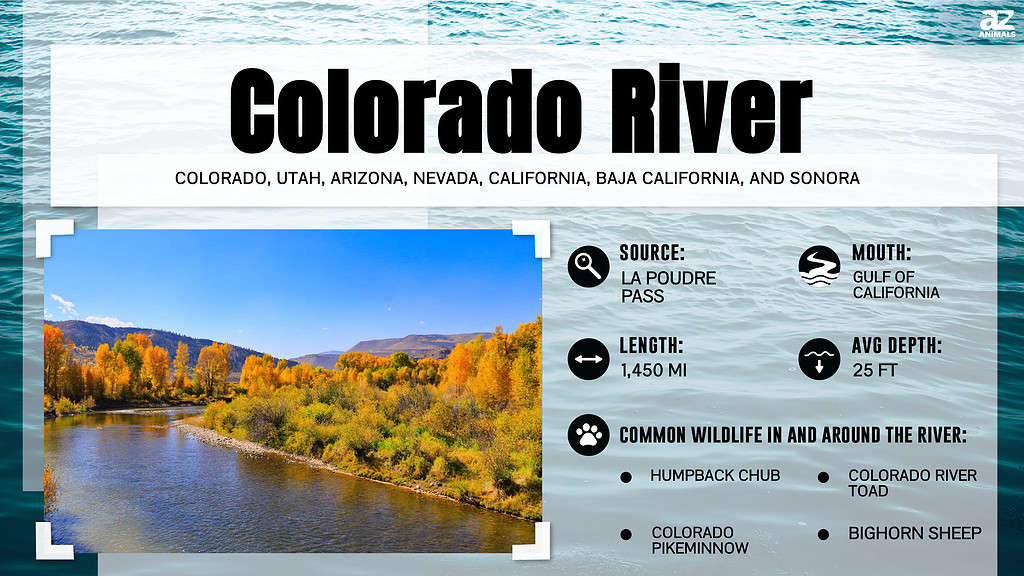
Current Water Levels of the Colorado River and How It Compares to History
Before we dive into expert predictions, it’s essential to understand the current state of the Colorado River.
How are water levels in reservoirs faring? And what’s happening with streamflow and snowpack conditions?
The Colorado River is going through a tough time. The problems have been building up for years, and now we’re at a breaking point. The water levels in the river’s main reservoirs have dropped a lot. That’s why the Biden administration is asking the 40 million people who depend on the river to use less water.
This situation is creating some hard decisions in the Western U.S. People must figure out how to balance the water needs of fast-growing cities with the need to save water for farming areas that grow most of our winter veggies. And then there’s the question of whether to prioritize those who have had water rights for a long time, like farming communities that claimed the water legally before the cities did.
Six of the seven states along the Colorado River are on board with a plan to reduce water use, getting close to what the Biden administration wants. But California, the biggest water user on the river, hasn’t agreed yet. And that’s making officials in the West worried about conflicting plans.
As more people across the country start paying attention to what’s happening with the Colorado River, we’re looking into some questions about the river and the distribution of its precious water.
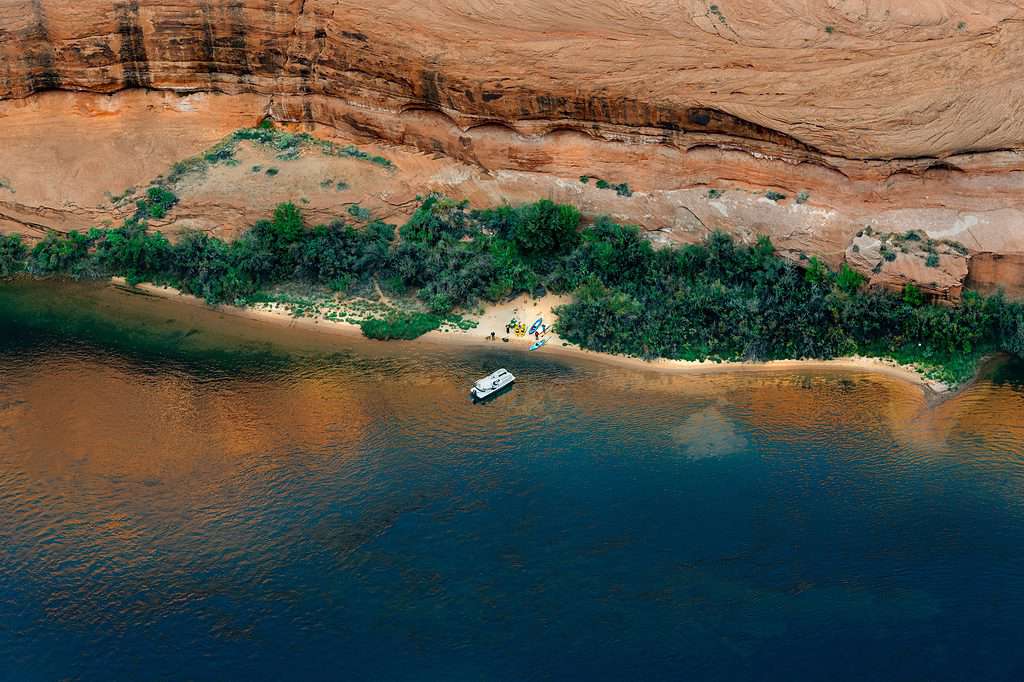
The Colorado River in Glen Canyon, Utah. The Colorado River sustains the ecosystems, economies, and communities across seven U.S. states!
©HannaTor/Shutterstock.com
Recent Water Level Trends: A Cause for Concern
Over the past few decades, the Colorado River has experienced a consistent decline in water levels. Recent years have been particularly challenging, with the river facing one of the most severe droughts in its recorded history. This downward trend in water levels has raised alarm bells among water managers, environmentalists, and the general public alike.
Reservoir Water Levels: A Tale of Two Lakes
Lake Mead and Lake Powell are two critical reservoirs in the Colorado River Basin, responsible for storing vast amounts of water. But recent years have seen these reservoirs experience historically low water levels, sparking concern about their ability to meet the region’s water demands. Monitoring and managing these reservoirs will ensure the river’s long-term health and the water security of millions of people.
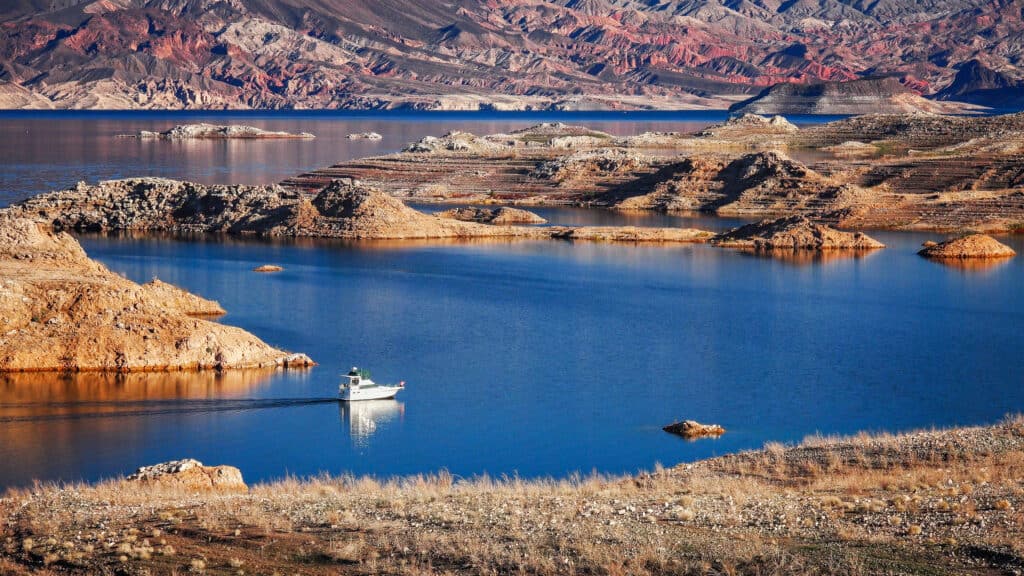
A boat enters a narrow channel on Lake Mead reservoir on the Colorado River in Nevada.
©iStock.com/CrackerClips
Streamflow and Snowpack: Melting Hopes
The health of the Colorado River is closely tied to the streamflow and snowpack conditions in its watershed. Snowmelt from the Rocky Mountains is a vital water source for the river, but climate change is causing snowpack to dwindle and melt earlier. This results in reduced streamflow and increased vulnerability to drought. Keeping an eye on these conditions and developing strategies to adapt to changing snowpack patterns will be key to the river’s future.
Comparing Current Levels to Historical Records: A River in Flux
When we compare the Colorado River’s current water levels to historical records, it’s evident that the river is experiencing a significant shift. In the early 20th century, the river’s flow was much higher and more stable than it is today. The current levels are, in some cases, among the lowest ever recorded. This highlights the urgency of addressing water scarcity issues.
Implications for the River’s Future: Charting a Sustainable Course
The comparison between current water levels and historical records underscores the Colorado River’s challenges. As water levels continue to decline, we must implement sustainable water management practices and adapt to changing conditions.
Is the Colorado River Drying Up in 2024?
The Colorado River might not dry up completely. But there’s a good chance it won’t provide enough water for the 40 million people who depend on it. No one knows when this could happen, but many experts think the drought will only worsen, which means we need to save water.
Everyone involved has to work together to agree on how to cut back on water use and keep the river and reservoir system stable. The stakeholders include:
- The seven states in the Colorado River Basin
- The Tribes
- Irrigation districts
- Cities
- Industries
- The federal government
The Bureau of Reclamation thinks the water level in Lake Mead will keep going down over the next few years, maybe even getting as low as 992 feet by the end of July 2024. But the good news is, there’s still time to do something about it.
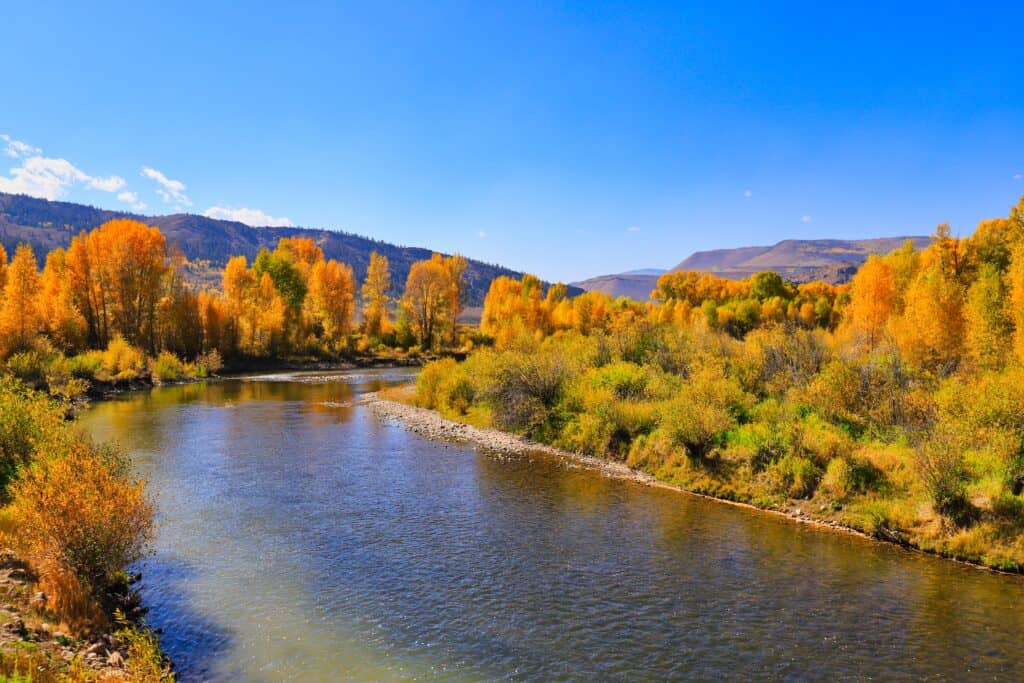
The Colorado River near Granby, Colorado during the fall. As water levels continue to decline, we must implement sustainable water management practices.
Expert Predictions and Projections
As we try to get a glimpse of the future of the Colorado River, let’s look at what experts are predicting.
What Climate Models Tell Us
Climate models give us an idea of how temperature and precipitation changes might impact the Colorado River Basin. Experts predict that warming trends will increase evaporation rates, while precipitation forecasts remain uncertain. This means we could see more variability in rainfall, along with more extreme weather events like droughts and floods. The overall outcome? A reduction in river flows, partly due to decreased snowpack in the Rocky Mountains and accelerated snowmelt.
Hydrological Models and Water Availability
Next, let’s consider hydrological models. These help us understand how water availability might change due to reduced streamflow, groundwater depletion, and varying water demands across the basin. Reservoir storage, like at Lake Mead and Lake Powell, could be significantly affected, making the need for sustainable groundwater management even more critical. Experts also suggest looking into alternative water sources and innovative strategies, such as aquifer recharge projects and conjunctive use.
The Role of Socioeconomic Factors
Finally, we can’t forget about the human element. Population growth in the Southwest will increase urban and agricultural water demands, so we need to consider equitable water allocation and distribution. The good news is that there’s potential for more efficient water use. We can work together to safeguard our precious water resources by:
- Investing in water-saving technologies and practices
- Raising public awareness
- Offering policy incentives
What Determines the Water Level in the Colorado River?
A complex interplay of natural and human factors influences the water level of the Colorado River.
Snowpack and Snowmelt: Nature’s Water Supply
One of the primary factors determining the water level in the Colorado River is the snowpack and snowmelt from the Rocky Mountains. Snowmelt is a vital water source for the river, replenishing its flow each spring and early summer. But as climate change alters snowpack dynamics, the river’s water levels can become more unpredictable and vulnerable to drought.
Precipitation Patterns: Raindrops and Ripples
Precipitation, in the form of rain and snow, also significantly determines the river’s water levels. The amount and timing of precipitation can influence the river’s flow and overall health. Climate change can alter precipitation patterns, leading to reduced water availability and increased variability in the river’s flow.
Evaporation Rates: Water’s Vanishing Act
Evaporation is another factor that affects the water level in the Colorado River. As temperatures rise due to climate change, evaporation rates increase, losing more water from the river system. This water can exacerbate water scarcity issues, particularly during drought.
Water Withdrawals and Diversions: Human Influence
Lastly, human activities, such as water withdrawals and diversions for agriculture, urban use, and other purposes, significantly impact the river’s water levels. As the population in the Colorado River Basin grows, and the demand for water increases, managing these withdrawals and diversions sustainably will help maintain the river’s flow and health.

The Colorado River in Austin, Texas. Water withdrawals and diversions for agriculture, urban use, and other purposes, significantly impact the river’s water levels.
©iStock.com/RoschetzkyIstockPhoto
Potential Solutions and Adaptation Strategies
Now that we’ve explored the factors contributing to the Colorado River’s decline and the challenges it faces, it’s time to look at potential solutions and adaptation strategies.
Water Conservation Measures: Every Drop Counts
One key strategy for addressing water scarcity in the Colorado River Basin is adopting water conservation measures. This includes:
- Implementing efficient irrigation techniques
- Promoting water-saving practices in urban areas
- Encouraging the use of drought-tolerant landscaping
Interstate Cooperation: Working Together for the River
Since multiple states and even countries share the Colorado River’s water resources, fostering interstate cooperation is crucial. By working together to develop coordinated water management plans, the states in the Colorado River Basin can help ensure fair and sustainable water allocation, addressing the challenges of overallocation and competing demands.
Innovative Technologies: Embracing the Future
Investing in innovative technologies can also significantly address water scarcity in the Colorado River Basin. For example, desalination technologies can help turn brackish or seawater into freshwater, providing additional water sources for the region. Additionally, water reuse and recycling technologies can help stretch existing water supplies further, reducing the pressure on the river.
Ecosystem Restoration and Management: Healing the River
Restoring and managing ecosystems in the Colorado River Basin is essential for protecting the river’s health and ensuring its long-term sustainability. This includes efforts to:
- Remove invasive species
- Restore riparian habitats
- Improve in-stream flows
By focusing on ecosystem restoration, we can help support the river’s biodiversity and enhance its resilience to climate change and other stressors.
Animals in and Around the Colorado River
Now that we understand the Colorado River’s importance let’s dive into the world of animals that call this river home or rely on it for sustenance. The Colorado River is home to diverse wildlife that has adapted to thrive in its unique ecosystem.
Native Fish Species: Swimming in a River of Life
The Colorado River is teeming with native fish species, each with unique characteristics and survival strategies. Here are a few examples:
- Razorback sucker. This endangered fish has a distinct hump just behind the head, resembling a wild hog’s razorback. It can grow up to 3 feet long and is primarily found in the river’s slower-moving waters.
- Humpback chub. Another endangered species, the humpback chub, has a distinctive fleshy hump behind its head. It’s well-adapted to the river’s turbulent waters and can often be found in the deep, fast-flowing sections of the Colorado River.
- Colorado pikeminnow. This large, predatory fish was once abundant in the Colorado River but is now considered endangered. It can grow up to 6 feet long and has an elongated, torpedo-shaped body.
- Bonytail. The bonytail is the rarest and most endangered of the Colorado River’s native fish species. Its streamlined body with a thin, pencil-like tail allows it to maneuver through fast currents.
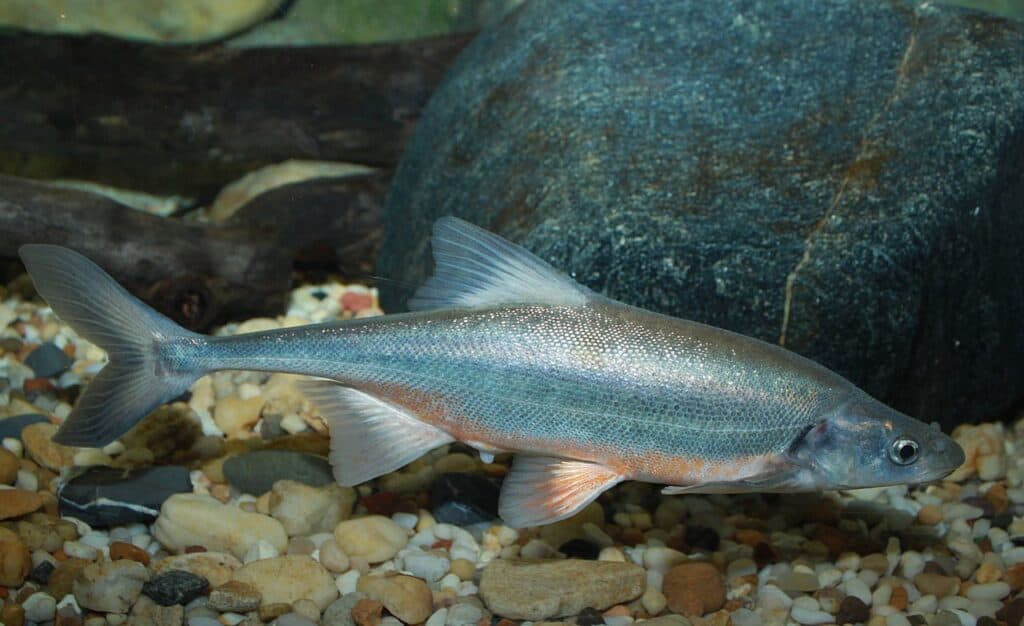
The bonytail is the rarest and most endangered of the Colorado River’s native fish species.
©Brian Gratwicke / CC BY 2.0, via Wikimedia Commons – Original / License
Mammals: Furry Friends of the River
The Colorado River also provides a habitat for various mammals, each uniquely adapted to the riparian environment:
- North American beaver. This semi-aquatic mammal has impressive dam-building skills. By creating dams and lodges, beavers help slow water flow, which can lead to the formation of wetlands and other valuable habitats.
- American mink. These agile and secretive carnivores are found along the riverbanks, feeding on fish, small mammals, and birds. They have luxurious, dark brown fur.
- Desert bighorn sheep. These iconic animals can be found in the Colorado River’s rocky terrain. They’re known for their agility, strength, and impressive, curled horns.
- River otter. Though not as common as they once were, river otters can still be found in parts of the Colorado River. These playful, intelligent mammals are expert swimmers and feed on fish, crayfish, and other aquatic creatures.
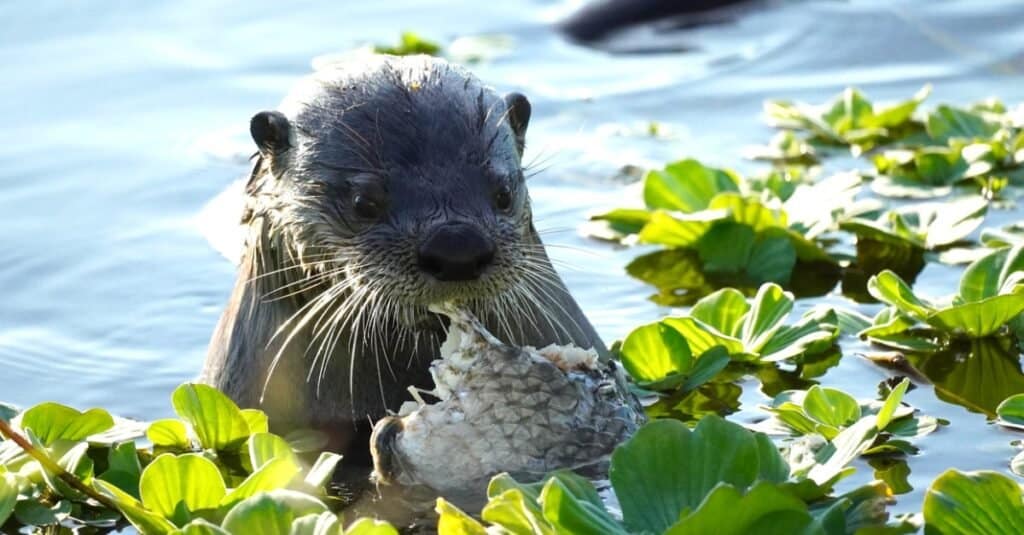
Though not as common as they once were, river otters can still be found in parts of the Colorado River.
©iStock.com/Troy Levengood
Reptiles: Cold-Blooded River Residents
Reptiles are also part of the Colorado River’s diverse ecosystem. Some notable examples include:
- Desert tortoise. This slow-moving, herbivorous reptile is adapted to survive in the arid regions surrounding the Colorado River. They have tough shells and can go long periods without water.
- Western diamondback rattlesnake. This venomous snake is famous for the distinctive rattling sound it makes with its tail to warn potential predators. It can be found in the rocky and sandy habitats near the river.
- Chuckwalla. This large, herbivorous lizard can often be spotted basking on rocks near the river. They can inflate their bodies with air when threatened, making them difficult for predators to extract from crevices.
- Gila monster. This venomous lizard is one of only two venomous lizards in North America. It has striking black and orange markings and lives in the deserts surrounding the Colorado River. Gila monsters spend most of their time in burrows and only emerge to hunt for birds, eggs, and small mammals.
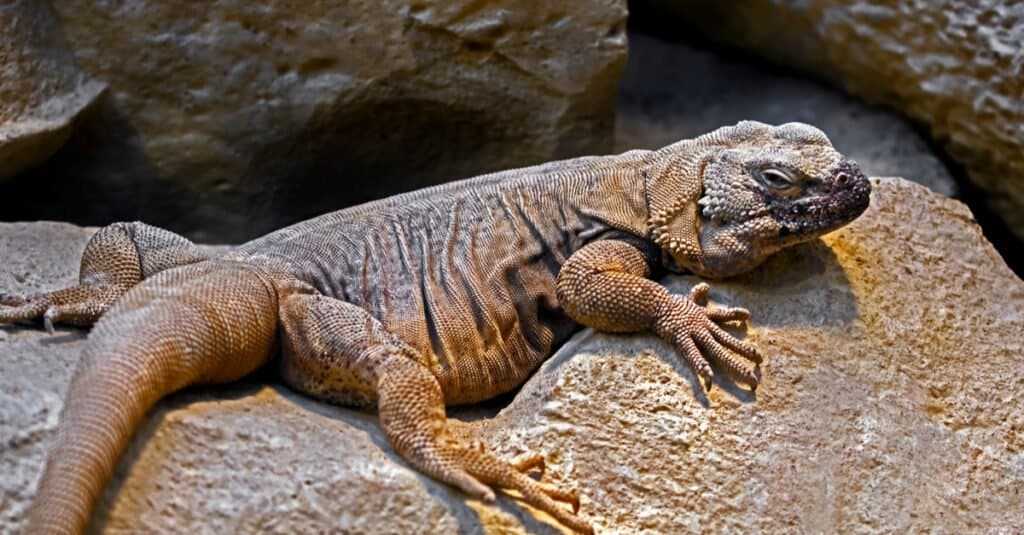
Chuckwallas can often be spotted basking on rocks near the river.
©Mikhail Blajenov/Shutterstock.com
Migratory Birds: Winged Visitors of the Colorado River
The Colorado River is a crucial stopover and nesting site for many migratory bird species. Some of these feathered friends include:
- Southwestern willow flycatcher. This small, endangered bird is known for its distinctive “fitz-bew” call. It prefers to nest in dense riparian habitats along the Colorado River, where it feeds on insects.
- Yellow-billed cuckoo. This elusive bird has a striking black-and-white plumage and distinctive yellow bill. It nests in the dense vegetation along the river and feeds on insects, small vertebrates, and fruits.
- Bald eagle. The majestic bald eagle is a well-known symbol of the United States. These impressive raptors can be found hunting for fish along the Colorado River during winter when they migrate to escape the colder climates.
- American white pelican. These large, social birds are often seen in groups along the Colorado River during their migration. They have striking white plumage, large wingspans, and a unique pouch used for catching fish.

The Southwestern willow flycatcher is a small endangered bird, known for its distinctive “fitz-bew” call.
©D and D Photo Sudbury/Shutterstock.com
Key Takeaways
As we’ve seen throughout this article, the Colorado River faces significant challenges threatening its water supply, ecosystems, and the millions of people who depend on it.
By exploring the factors contributing to the river’s decline and potential solutions, we’ve gained valuable insights into the path forward for this vital water resource.
The challenges facing the Colorado River underscore the importance of addressing water scarcity in the region. As climate change, overallocation, groundwater depletion, and human activities continue to impact the river, we must take collective action to ensure a sustainable future for the Colorado River Basin.
A collaborative and adaptive approach to water management is essential to address the challenges facing the Colorado River.
The photo featured at the top of this post is © iStock.com/Chris Szwedo
Thank you for reading! Have some feedback for us? Contact the AZ Animals editorial team.







